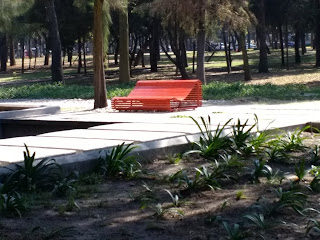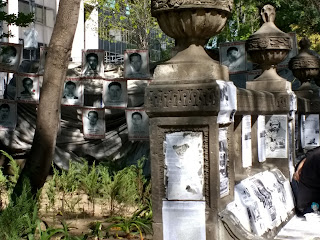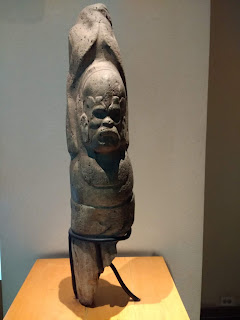Almost seven months since returning home from our fantastic adventure to South America and a few days in Mexico City at the end, I am finally writing the last post on the trip before doing one recap post! If you had told me so many months ago it would take me this long, I would have definitely poo-pooed you but planning for upcoming trips and volunteering here at home has taken up more of my energies than I would have thought.
After leaving one of the world's great museums, The Museum of Anthropology located in Mexico City's Chapultepec Park or Forest, we headed through the park to Paseo Reforma, the city's grandest boulevard.
After leaving one of the world's great museums, The Museum of Anthropology located in Mexico City's Chapultepec Park or Forest, we headed through the park to Paseo Reforma, the city's grandest boulevard.
At points throughout the trip, Steven and I had been talking about where we wanted to go next on our 'big trip,' i.e. the overseas one lasting several months we have been taking every fall since 2013. We had already visited many of the former Soviet republics but were interested in traveling to more of them. If one ever believed in 'signs' we had had our fair share of them already this trip indicating where we should go. One sign had been when I visited a fortune teller in Lima and asked whether we should visit some of the Stan countries or much of Western Europe that we had not yet been to. After chewing some coca leaves and waving his hands over and praying over more of them, the man had emphatically said the Stan countries were where we should go. Then, when we walked up the oh, so fun Selaron mosaic steps I wrote about in one of the Rio posts, one of the mosaic tiles was from Kazakhstan. Then, to top it all off, here we were in Mexico City and almost the first thing we come across on the Paseo Reforma was this huge sculpted map of Azerbaijan. I think that sealed where we would go in the fall of 2018!
In just over a month, after our third child gets married in less than a year, we'll be heading to Paris for a few days and then onto Armenia, Georgia, Azerbaijan, several of the Stan countries and then Spain, Portugal and the Netherlands with a few days thrown in in Andorra, Gibraltar and Tangier, Morocco and returning over four months later just before Christmas. I hope you'll enjoy reading some of those far shorter posts!
Back to the Paseo Reforma, a wide avenue that runs diagonally across the heart of Mexico City. It was designed by Ferdinand von Rosenzweig in the 1860s and modeled after the great boulevards of Europe, such as the Ringstrasse in Vienna and the Champs-Élysées in Paris. After the French intervention in Mexico overthrew the constitutional President Benito Juárez, the newly crowned Emperor Maximilian of Hapsburg made his mark on the conquered city. He commissioned a grand avenue linking the city center with his imperial residence, Chapultepec Castle (which we walked up to earlier that day) with the old city center. The street was originally named Paseo de la Emperatriz or Promenade of the Empress in honor of Maximilian's consort and second cousin Empress Carlota. After her return to Europe and Maximilian's subsequent execution, the restored Juárez government renamed the Paseo in honor of the Reform War.
A 2003 addition to the city's skyline was Torre Mayor, located just outside Bosque de Chapultepec. The earthquake-resistant structure, which soared 225 meters above the capital, was anchored below by 98 seismic shock absorbers as the city is often prone to earthquakes.
One of the highlights of the Paseo de la Reforma was that it linked a series of monumental and grand traffic circles. The 1942 bronze figure of La Diana Cazadora or Diana the Huntress was once thought to offend public decency. The League of Decency had the sculptor add a loincloth to the buxom figure which was actually meant to represent the Archer of the North Star and it wasn't removed until 1966.
I remember so clearly always being about twenty steps behind Steven as we walked down the stunning boulevard as I paused to take these photos! I would have liked to 'stop and smell the roses' on the Paseo but we were in a time crunch and had to return to our hotel and get our bags before our flight home to Denver so unfortunately we didn't have the time to sit on the attractive benches and watch the world go by.
The Monumento a la Independencia, more commonly known as The Angel, was sculpted for the independence centennial in 1910. I read that inside the monument were the remains of twelve important Mexicans. It would be great to see the gilded Winged Victory when thousands of people descend on the monument for occasional free concerts and victory celebrations following important Mexican soccer matches!
Doesn't this bench look like one of the most unusual and fun benches you've ever seen? I wish I could attest to its comfort but I only had time for a photo. I loved how art doubled as function.
I was pretty sure the girl was celebrating her quinceañera, the Hispanic tradition of celebrating a young girl's coming of age on her 15th birthday. I just read online that the celebrations "embrace religious customs, and the virtues of family and social responsibility."
Behind the fencing was all we could see of the US Embassy.
I didn't figure out what this was or represented but liked it even so!
The mirror-ball building in front of a futuristic pencil-thin building comprised the city's Bolsa de Valores or Stock Exchange.
Up and down the two mile stretch of Paseo del a Reforma were a series of smaller statues commissioned in the 19th century of prominent Mexicans from each state.
It was troubling seeing all the posters reminding passersby of the 43 students who disappeared on September 26th and 27th, 2014.
I wish I understood the meaning behind the words which translate to "They do not need us to fail. We do not need them to survive."
How tragic it must be for the students' families who had been searching for their loved ones for 1,185 days as of December 21st, 2017.
I wondered again how comfortable these concrete 'sofas' were!
This monument was of José Eduardo de Cárdenas, a priest, theologian, politician, poet and writer.
The walk down la Reforma was like an architectural event with different styles and periods making it a fun exploration.
One of the busiest intersections was marked by the Monumento a Cuauhtémoc which honored the last Aztec emperor against the Spanish invaders.
I loved the juxtaposition of the old monuments and the new skyscrapers up and down the long avenue.
So much of the architecture was very intriguing.
This was the Congress of the Union, the seat of the federal government of Mexico which consisted of the Senate of the Republic and the Chamber of Deputies.
A few blocks away was the Monumento a Cristóbal Colón or Christoper Columbus as we know him that showed him gesturing toward the horizon.
This is one of my favorite photos of the Paseo, again showing the old and new.
The bar in the Imperial Hotel was known for its Carajillo 43, a classic Spanish cocktail normally made with coffee and brandy that is very popular in Mexico.
The Loteria Nacional building, completed around 1936, included details of Art Deco craftsmanship.
The El Cabalito was a bright yellow representation of a horse's head which commemorated another horse sculpture that stood in the same spot for 127 years before being moved to the National Art Museum. I was glad I had information about the sculpture as I don't think I'd have known it was a horse's head otherwise!
There was so much to love in our short visit to Mexico City: the fabulous murals of Diego Rivera and his fellow muralists, the sinking Metropolitan Cathedral, the ancient temples and pyramids of Teotihuacan, the engrossing Anthropology Museum, and to top it all off, the very enjoyable stroll along the Paseo. But more than just the sights we saw, the city was a wonderful surprise where so few people smoked, we saw no graffiti in the historic center, only a handful of people were sleeping in the streets and the center was incredibly clean. We so often read of the violence in the city and the rest of the country but for us, we experienced nothing but positives.
Next post: Some photos of some of our favorite places from our three and a half months in South America - I am NOT looking forward to going through almost 150 posts to find them, mind you! The trip had been absolutely fabulous even with some scary hiccups along the way but in our minds even they contributed to the 'adventure' as we call these long trips.
Posted on July 11th, 2018, from sweltering Littleton, Colorado.

























































































































































